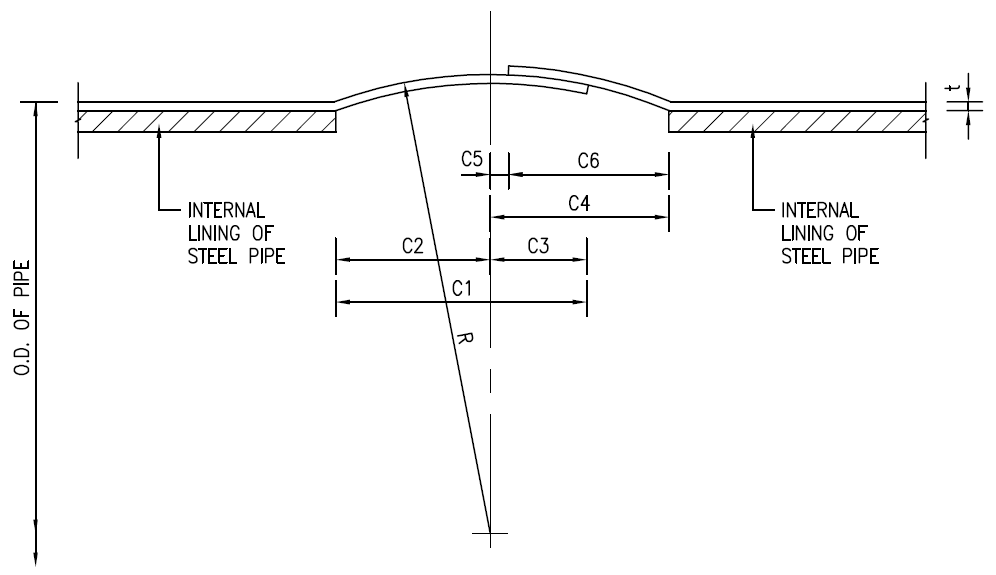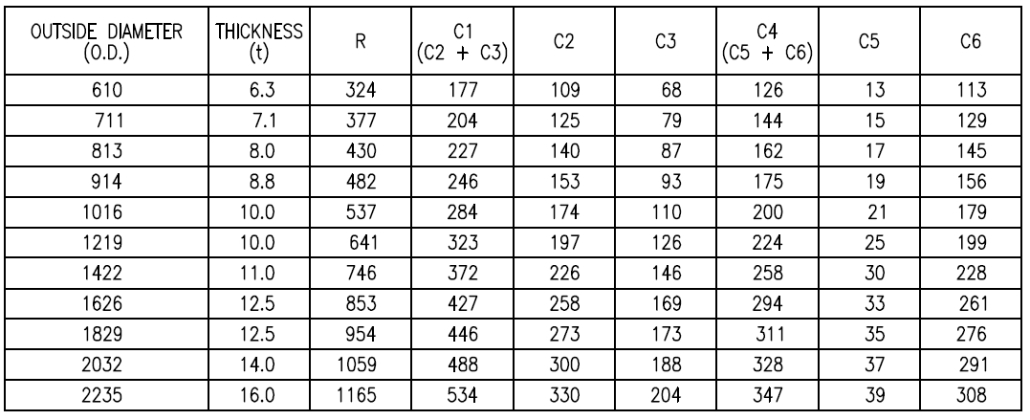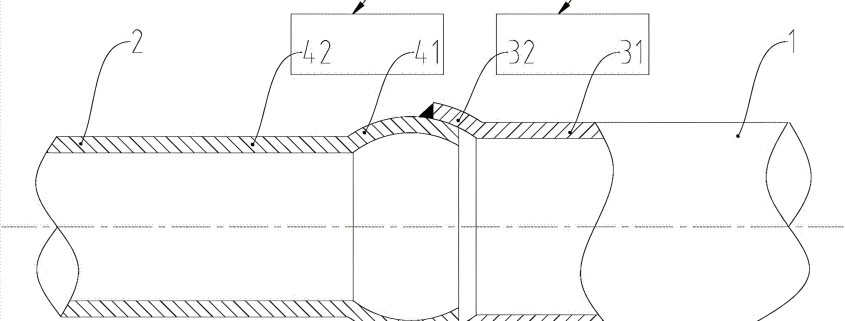Spherical Spigot and Socket Joints for Steel Pipes
Pipeline systems are integral to the transportation of essential resources such as water, oil, and gas. Whether onshore or offshore, pipeline joints’ durability, flexibility, and ease of installation play a significant role in ensuring long-term reliability and operational efficiency. Among the various types of pipeline connections, spherical spigot and socket joints are one of the most reliable and versatile solutions, particularly in projects involving 3LPE, 3LPP, FBE, and Liquid Epoxy coatings for water pipelines.
The existing traditional welded steel pipe is generally straight butt-jointed. During installation, due to the deviation of the same roundness of the pipe body port, there is a misalignment phenomenon in the joint, which makes the joint challenging to join during the construction process, and the quality of manual welding is difficult to guarantee, resulting in a decrease in the strength of the weld joint, and the weld seam of the weld joint is prone to stress concentration and bursting. When the pipe body is joined, each joint cannot be implemented to swing axially due to on-site construction requirements, thereby extending the joining time, increasing construction costs, and reducing efficiency.
The spigot and socket joints welded steel pipe includes a hollow straight pipe body. The two ends of the pipe have spherical expansion ports: a socket and a spigot, and the socket and the pipe body are arc transitions. The outer diameter of the spigot is slightly smaller than the socket’s inner diameter, and the spigot’s arc end can be extended into the inner wall of the socket to form an overlap. It can swing or rotate axially along the inner wall of the socket by 6° to 10°.
In this blog post, we’ll dive deep into what spherical spigot and socket joints are, their benefits, how they work, and why they are essential in coated pipeline projects. We’ll also explore how these joints are manufactured and the key specifications you should consider for your pipeline design.
What Are Spherical Spigot and Socket Joints?
UN spherical spigot and socket joint is a type of mechanical connection used to join two steel pipes. The connection consists of two parts: a spigot (the male end) and a socket (the female end). The unique feature of this joint is its spherical shape, which allows it to accommodate angular deflections and misalignments between the two connected pipes.
This design is particularly useful in pipeline systems that must endure various dynamic forces such as thermal expansion, seismic activity, soil movement, and vibrations. The spherical nature of the joint enables the two pipes to rotate relative to one another without compromising the integrity of the seal.
How Spherical Spigot and Socket Joints Work
Le spigot is inserted into the socket, with the spherical geometry allowing for movement at multiple angles. The tight fit of the joint, combined with the flexibility offered by the spherical design, ensures a leak-proof seal. Additionally, the spherical shape can handle angular deflection in the joint, which helps the pipeline accommodate slight misalignments or changes in position without creating stress on the overall system.
The joint may also incorporate sealing mechanisms such as gaskets or O-rings to ensure that the connection remains leak-free under various operational conditions.
Why Use Spherical Spigot and Socket Joints in Coated Water Pipelines?
Pipeline systems coated with 3LPE (polyéthylène à trois couches), 3LPP (Three-Layer Polypropylene), FBE (Fusion Bonded Epoxy), ou Liquid Epoxy coatings are designed to resist corrosion and external environmental factors. However, while these coatings are highly effective in preventing corrosion, they can also be vulnerable to damage if the joints and connections aren’t designed to handle the natural movement of the pipes.
Here’s why spherical spigot and socket joints are the ideal solution for coated pipeline projects:
-
Accommodating Pipe Movement:
Accommodating angular deflection is critical in pipelines exposed to external forces, such as temperature fluctuations, soil movement, or seismic activity. Spherical spigot and socket joints allow pipes to move or shift relative to each other without stressing the joints or damaging the protective coating. -
Maintaining the Integrity of the Coating:
The flexibility these joints provide helps minimize the risk of cracks or deformations that could damage the coating. Since the coating is often the first line of defense against corrosion, maintaining its integrity is crucial for the longevity of the pipeline. -
Reduced Risk of Corrosion:
When properly sealed, these joints ensure that moisture, dirt, and other corrosive elements cannot penetrate the pipeline. Additionally, since the joint design minimizes stress on the pipeline, the risk of stress-induced corrosion is lower. -
Durabilité améliorée:
Steel pipes combined with high-quality coatings and robust joint designs, such as spherical spigot and socket joints, can withstand harsh environmental conditions, such as exposure to seawater in offshore projects or soil corrosion on land-based pipelines. -
Cost-Effective and Efficient Installation:
These joints are easier to install than other rigid connections, saving time and reducing labor costs. Their ability to accommodate angular misalignment means that installation doesn’t require exact pipe alignment, which can be difficult in certain terrains or under adverse conditions. -
Flexible Adjustment of Pipe Angles:
Spherical spigot and socket joints also allow for easy adjustment of the pipeline laying angle, typically from 6° to 10°. This capability reduces the need for additional pipe fittings, simplifies the installation process, and saves on material costs, ultimately improving overall efficiency.
How Spherical Spigot and Socket Joints Are Manufactured
The manufacturing process for spherical spigot and socket joints is highly specialized and involves several key steps to ensure precision, strength, and durability. Here’s an overview of the typical production process:
-
Sélection des matériaux:
Depending on the application, the joints are typically made from high-strength steel alloys, such as carbon steel. Materials are selected based on the desired strength, resistance to corrosion, and compatibility with the pipeline’s intended use (e.g., oil, gas, or water transport). -
Forging or Casting:
The spigot and socket are usually forged or cast to form the basic shape of the joint. Forging offers superior strength and durability, while casting is a more cost-effective option for larger volumes. The spherical shape is carefully designed to ensure that both ends fit perfectly. -
Machining and Shaping:
After the spigot and socket are forged or cast, they undergo machining to ensure precision. This step involves turning, milling, and drilling to achieve the correct dimensions, surface finishes, and tolerance levels. The spherical geometry is particularly important to ensure smooth movement and deflection between the two parts. -
Traitement thermique:
Heat treatment processes such as quenching and tempering are often employed to improve the joint’s mechanical properties, including strength, toughness, and resistance to wear and corrosion. This step is critical to achieving long-term reliability under high-pressure and dynamic conditions. -
enrobage:
After the joint is manufactured, it may undergo surface treatments such as 3LPE, 3LPP, FBE, ou Liquid Epoxy coatings, depending on the project’s requirements. These coatings provide excellent corrosion protection, ensuring that the joint remains durable even in harsh environments, such as offshore oil and gas pipelines or water distribution systems. -
Inspection et test:
Once the joints are manufactured, they undergo rigorous inspection and testing to ensure they meet industry standards and specifications. Common tests include visual inspections, dimensional checks, pressure testing, and non-destructive testing (NDT) methods like ultrasonic or X-ray inspections to detect any internal flaws.
Specifications for Spherical Spigot and Socket Joints
The specifications for spherical spigot and socket joints can vary depending on the type of pipeline, the materials used, and the environmental conditions. However, some common specifications include:
-
Dimensions:
- Spigot Outer Diameter (OD): For a tight fit, the spigot’s outer diameter must match the inner diameter of the socket.
- Socket Inner Diameter (ID): The socket’s internal diameter should be slightly larger than the spigot’s outer diameter to allow for smooth insertion.
- Joint Length: The length of the spigot and socket is typically designed to ensure a secure and robust connection, usually ranging from a few inches to several feet.

Drawing for Spherical Spigot and Socket Joints

Schedule of Dimensions for Spherical Spigot and Socket Joints

Coatings & Linings
-
Angular Deflection:
Depending on the application, the spherical joint should allow for an angular deflection of typically 6° to 10°. This provides flexibility in the alignment of the pipes during installation and operation. -
Pressure Ratings:
Pressure ratings are critical, particularly in oil and gas pipelines. The joints must withstand the pipeline system’s internal pressure, typically specified in PSI (pounds per square inch) or MPa (megapascals). -
Material Strength:
The joint material is typically rated based on yield and tensile strength. Depending on the pipeline’s requirements, common standards and material grades include EN 10224, EN 10217-1, AWWA C200, BS 534, ASTM A134, NF A49-150 etc. -
Épaisseur du revêtement:
The coating thickness (for 3LPE, 3LPP, FBE, or Liquid Epoxy) is specified to provide adequate protection against corrosion. Depending on environmental conditions and the aggressiveness of the surrounding environment, the coating thickness typically ranges from 1.5 mm to 3.0 mm.
Applications courantes
Spherical spigot and socket joints are widely used in à terre water pipeline projects. Here are some of the typical applications:
-
Systèmes de distribution d'eau:
Potable water pipelines, which need to operate for decades without failure, benefit from the flexibility of spherical joints. These joints help manage shifts in the pipeline due to soil conditions or seismic activities, ensuring a secure and continuous flow of water. -
Canalisations d'égouts et d'eaux usées:
Wastewater systems, especially those in regions prone to land shifts or flooding, require flexible pipeline joints to prevent leaks and maintain structural integrity. The spherical design helps accommodate these conditions.
Conclusion
Spherical spigot and socket joints are essential in modern pipeline systems, especially when combined with advanced corrosion-resistant coatings such as 3LPE, 3LPP, FBE, and Liquid Epoxy. In onshore water pipeline projects, these joints provide a reliable, flexible, and cost-effective solution for ensuring the structural integrity and longevity of the pipeline.
By using these joints, engineers can overcome challenges related to pipe movement, misalignment, and environmental factors, all while maintaining the protective coating and preventing corrosion. As pipeline infrastructure grows in complexity, spherical spigot and socket joints will remain a cornerstone of safe, efficient, and durable pipeline systems.
If you’re considering spherical spigot and socket joints for your next pipeline project for water distribution, we are a reliable manufacturer and supplier that offers high-quality products that meet industry standards. Proper installation and maintenance will guarantee the long-term success of your pipeline system. Please feel free to contact us at [email protected] for a competitive quote!




